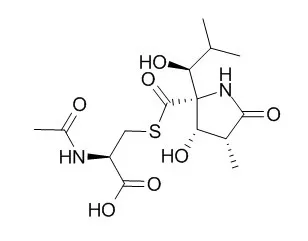| Description: |
Lactacystin is a selective UPS inhibitor recently used to destroy dopamine (DA) neurons in animal models of Parkinson's disease (PD); marked differences in the rotational response to apomorphine and l-DOPA suggest different mechanisms of neurodegeneration evoked by Lactacystin and 6-OHDA. Lactacystin induces cell death and α-synuclein-positive inclusions in cytoplasm, it has diversified killing effects on gastric cancer cells, the mechanism may be related to induce the apoptosis by downregulation of nuclear factor kappa B viability. |
| Targets: |
GABA Receptor | HDAC | NF-kB | p65 | Caspase |
| In vitro: |
| Tumour Biol. 2015 May;36(5):3465-70. | | Investigation the mechanism of the apoptosis induced by lactacystin in gastric cancer cells.[Pubmed: 25541208] | The study aims to investigate the relationship between nuclear factor (nuclear factor kappa B (NF-κB)) viability and Lactacystin-mediated cell apoptosis in gastric cancer cells.
METHODS AND RESULTS:
Two gastric cancer cell lines (MKN28 and SGC7901) were treated with Lactacystin-a proteasome inhibitor for 24 h. The cell viability, toxicity, and death were measured by 3-(4,5-dimethylthiazol-2-yl)-2,5-diphenyltetrazolium bromide (MTT) method. DNA binding viability of NF-κB and caspase-3 viability were analyzed by ELISA; the expression of p65 NF-κB nuclear protein was detected by immunocytochemistry and Western blot. Lactacystin reduced DNA binding viability of NF-κB (t = 3.0,P = 0.013) and the NF-κB viability (compared to the 5, 10 μmol/L MKN28 cell (p53 mutant) line, P < 0.001) and the expression of p65 NF-κB nuclear protein decreased parallelled to concentrations of Lactacystin in MKN28 cell line, while without obvious effects on NF-κB viability in SGC7901 cell line (P = 0.381), while the viability of caspase-3 increased also along with the raising of Lactacystin concentrations (compared to control, 5 μmol/L: SGC7901 cell line P = 0.029, MKN28 cell line P < 0.001; 10 μmol/L: SGC7901 cell line, P < 0.001, MKN28 cell line, P < 0.001).
CONCLUSIONS:
It was concluded that Lactacystin had diversified killing effects on gastric cancer cells. The mechanism may be related to induce the apoptosis by downregulation of nuclear factor kappa B viability. There may be additional cell survival/death pathway in SGC7901 gastric cancer cells. |
|
| In vivo: |
| Behav Brain Res. 2015 Apr 15;283:203-14. | | Decreased behavioral response to intranigrally administered GABAA agonist muscimol in the lactacystin model of Parkinson's disease may result from partial lesion of nigral non-dopamine neurons: comparison to the classical neurotoxin 6-OHDA.[Pubmed: 25655509] | Lactacystin is a selective UPS inhibitor recently used to destroy dopamine (DA) neurons in animal models of Parkinson's disease (PD). However, both in vitro and in vivo studies show discrepancies in terms of the sensitivity of non-DA neurons to its toxicity.
METHODS AND RESULTS:
Therefore, our study was aimed to examine the toxic effect of intranigral administration of Lactacystin on DA and non-DA neurons in the rat substantia nigra (SN), compared to the classic neurotoxin 6-OHDA. Tissue DA levels in the striatum and SN and GABA levels in the SN were also examined. Moreover, behavioral response of nigral GABAA receptors to locally administered muscimol was evaluated in these two PD models. We found that both Lactacystin and 6-OHDA induced a strong decrease in DA level in the lesioned striatum and SN but only Lactacystin slightly reduced GABA levels in the SN. A stereological analysis showed that both neurotoxins highly decreased the number of DA neurons in the SN, while only Lactacystin moderately reduced the number of non-DA ones. Finally, in the Lactacystin group, the number of contralateral rotations after intranigrally administrated muscimol was decreased in contrast to the increased response in the 6-OHDA model.
CONCLUSIONS:
Our study proves that, although Lactacystin is not a fully selective to DA neurons, these neurons are much more vulnerable to its toxicity. Partial lesion of nigral non-DA neurons in this model may explain the decreased behavioral response to the GABAA agonist muscimol. | | Br J Pharmacol. 2015 Aug;172(16):4200-15. | | Neurorestoration induced by the HDAC inhibitor sodium valproate in the lactacystin model of Parkinson's is associated with histone acetylation and up-regulation of neurotrophic factors.[Pubmed: 26040297] | Histone hypoacetylation is associated with Parkinson's disease (PD), due possibly to an imbalance in the activities of enzymes responsible for histone (de)acetylation; correction of which may be neuroprotective/neurorestorative. This hypothesis was tested using the anti-epileptic drug sodium valproate, a known histone deacetylase inhibitor (HDACI), utilizing a delayed-start study design in the Lactacystin rat model of PD.
METHODS AND RESULTS:
The irreversible proteasome inhibitor Lactacystin was unilaterally injected into the substantia nigra of Sprague-Dawley rats that subsequently received valproate for 28 days starting 7 days after Lactacystin lesioning. Longitudinal motor behavioural testing, structural MRI and post-mortem assessment of nigrostriatal integrity were used to track changes in this model of PD and quantify neuroprotection/restoration. Subsequent cellular and molecular analyses were performed to elucidate the mechanisms underlying valproate's effects.
Despite producing a distinct pattern of structural re-modelling in the healthy and Lactacystin-lesioned brain, delayed-start valproate administration induced dose-dependent neuroprotection/restoration against Lactacystin neurotoxicity, characterized by motor deficit alleviation, attenuation of morphological brain changes and restoration of dopaminergic neurons in the substantia nigra. Molecular analyses revealed that valproate alleviated Lactacystin-induced histone hypoacetylation and induced up-regulation of brain neurotrophic/neuroprotective factors.
CONCLUSIONS:
The histone acetylation and up-regulation of neurotrophic/neuroprotective factors associated with valproate treatment culminate in a neuroprotective and neurorestorative phenotype in this animal model of PD. As valproate induced structural re-modelling of the brain, further research is required to determine whether valproate represents a viable candidate for disease treatment; however, the results suggest that HDACIs could hold potential as disease-modifying agents in PD. |
|






 Cell. 2018 Jan 11;172(1-2):249-261.e12. doi: 10.1016/j.cell.2017.12.019.IF=36.216(2019)
Cell. 2018 Jan 11;172(1-2):249-261.e12. doi: 10.1016/j.cell.2017.12.019.IF=36.216(2019) Cell Metab. 2020 Mar 3;31(3):534-548.e5. doi: 10.1016/j.cmet.2020.01.002.IF=22.415(2019)
Cell Metab. 2020 Mar 3;31(3):534-548.e5. doi: 10.1016/j.cmet.2020.01.002.IF=22.415(2019) Mol Cell. 2017 Nov 16;68(4):673-685.e6. doi: 10.1016/j.molcel.2017.10.022.IF=14.548(2019)
Mol Cell. 2017 Nov 16;68(4):673-685.e6. doi: 10.1016/j.molcel.2017.10.022.IF=14.548(2019)